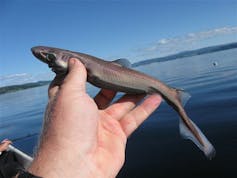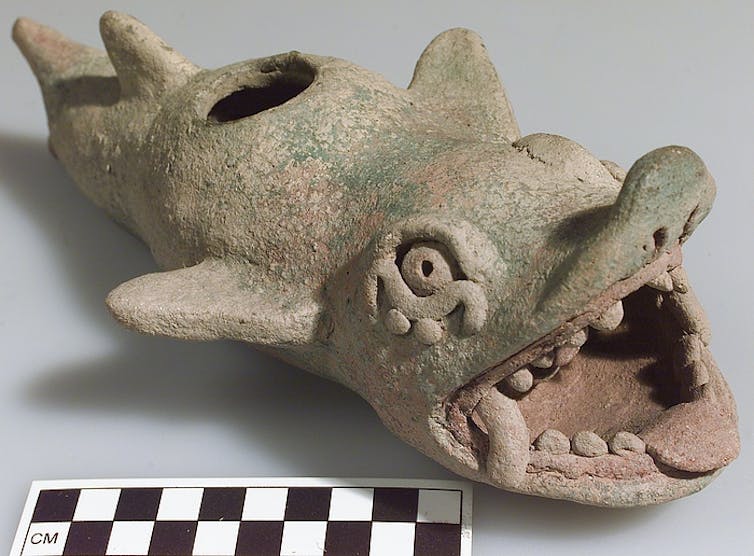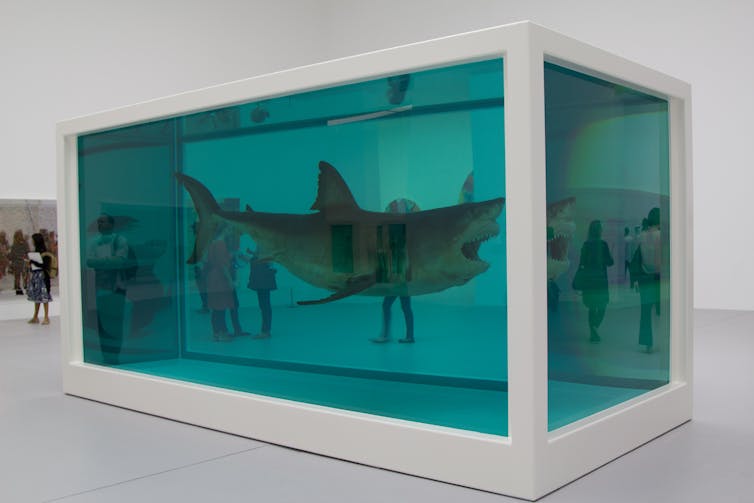The Meg is a horror story but our treatment of sharks is scarier
- Written by Vivienne Westbrook, Honorary Adjunct Professor and Senior Research Fellow, Oceans Institute, University of Western Australia
After 20 years of development hell, the film The Meg opens in Australia this week. The screenplay is based on the first of Steve AltenŌĆÖs six-book, horror sci-fi series. The film has been pitched as an action-packed thriller, centring on our hero, naval captain and diver Jonas Taylor (played by Jason Statham) and his monstrous fishy nemesis. The pre-launch trailer, featuring frightening scenes of the Meg set to Beyond the Sea, a chirpy love song first popularised by Bobby Darin, suggests we shouldnŌĆÖt take the film too seriously. But, then again, perhaps we should.
Meg, a larger than life, 22-metre, toothsome monster, is only the latest in a long history of human representations of sharks. Our fascination with these imagined monsters is apparently insatiable. But fictionalised versions, with their threatening fins, chomping jaws and general grudge against humanity, have tended to blind us to what is truly amazing about the sharks in our oceans. Confusing what we know about sharks in movies with what we know about real sharks is chiefly what has led to them being seen as pests that must be slaughtered.
Historically, shark research has been underfunded, which is why so much mystery and so many myths have surrounded them. Yet we are beginning to realise just how crucial sharks are to the healthy oceans on which all human life depends.
 A dwarf lantern shark, probably the smallest species.
Wikimedia
A dwarf lantern shark, probably the smallest species.
Wikimedia
Sharks have lived on the planet for around 450 million years and proven to be extremely resilient in having survived, in various forms, all five mass extinctions. Their current challenge, however, is to survive the Anthropocene.
Megalodon, or Carcharocles megalodon, was probably more closely related to a group of extinct sharks rather than the ancestor of todayŌĆÖs great white sharks. It first appeared around 23 million years ago, roughly 42 million years after the extinction that wiped out the larger dinosaurs, and was last in evidence around 2.6 million years ago.
Read more: Giant monster Megalodon sharks lurking in our oceans: be serious!
Most taxonomists will agree that there are currently between 450 and 500 species of shark in our oceans. Some have evolved to survive at depths of 3,000 metres while others live much closer to the surface. Most can only survive in salt water, but the bull shark can also navigate in fresh water. They range from the 15-22 cm, krill-eating, dwarf lantern shark, among the smallest fish, to the 12 m plankton-eating, whale shark, the largest fish of all.
 Whale sharks are the largest living fish.
Shutterstock
Whale sharks are the largest living fish.
Shutterstock
Sharks are extraordinary and diverse creatures. They are tasked with maintaining a healthy balance in the oceans by keeping other fish and mammal populations in check, and by cleaning up dead and dying organisms from the 70% of our planet that we still regard as a blue refuse bin. Yet with around 100,000,000 sharks being fished out of the oceans each year, it is perilous for us to ignore marine scientistsŌĆÖ warnings of the devastating consequences of over-fishing. Large shark species can take years to reach sexual maturity, have slow reproductive cycles and produce only a few pups, which are highly vulnerable to larger oceanic predators.
Sharks imagined
If sharksŌĆÖ vital contribution to the health of our planet has tended to be ignored, the evidence of their contribution to human culture is ubiquitous. Uses for sharks vary from weaponry to ŌĆ£pharmazooticalsŌĆØ. Shark teeth have served as clubbed weapons, cutting tools and ceremonial and general ornaments; their fins as food, their skin as sandpaper, and their liver and cartilage as treatments for ailments from the common cold to cancer.
Sharks have long been imagined and represented across the worldŌĆÖs languages and cultures as a force to be reckoned with. An increasing body of archaeological and anthropological work testifies to the incorporation of sharks in Mayan culture, for instance, as part of its language system, in the representation of deities (with ritualised use of the teeth of sharks and even fossilised Megalodons), and in exquisite stone carvings depicting human and shark relationships.
 A Mayan vessel of a shark with a man in its mouth, circa AD 1450-1550.
National Museum of the American Indian
A Mayan vessel of a shark with a man in its mouth, circa AD 1450-1550.
National Museum of the American Indian
Australian Aboriginal cultures have long used sharks in their Dreamtime to explain natural phenomena such as the emergence and shape of rivers. Polynesian cultures honoured sharks as their ancestors in stories, songs and dances that are still remembered today.
Whether of Mayan ŌĆ£xocŌĆØ, German ŌĆ£sherkŌĆØ or French ŌĆ£cherquierŌĆØ origin, ŌĆ£sharkŌĆØ officially became an English word in 1569 in a brief, illustrated pamphlet. This described how a ŌĆ£marveilous straungeŌĆØ creature caught in a mackerel fishing net was subsequently dissected, displayed and finally eaten by excited Londoners. Since then, there have been thousands of printed accounts of sharks: from short museum descriptions to exaggerated reports of monstrous attacks in newspapers to photos of bleeding trophy catches in fishing magazines.
Poets have also been drawn to sharks. Andrew Marvell used shark teeth to describe crippling commodity taxes in his Last Instructions to a Painter (1667), while John Greenleaf Whittier chillingly described sharks as the partners of slave-traders as they waited beneath boats for the diseased and dead to be tossed overboard in The Slave Ships (1894). James FentonŌĆÖs shark was the focus of a shared community supper in The Milkfish Gatherers (1993) and Carol Ann DuffyŌĆÖs shark was the central metaphor for being Jealous as Hell (1998).
 John Singleton Copley, Watson and the Shark, 1788.
Wikimedia
John Singleton Copley, Watson and the Shark, 1788.
Wikimedia
From the 16th century onwards, sharks have appeared in plays. William Shakespeare used sharks in the WitchesŌĆÖ toxic brew of Macbeth (1606), while William Congreve, (though not alone in this respect), used sharks to describe the theatre critics of his day in The Double Dealer (1693). In Joe CliffordŌĆÖs Every One (2010) the shark on the fish counter shouts out to JoeŌĆÖs conservation manifesto.
Sharks have been prominent in visual art since John WhiteŌĆÖs depictions of hammerheads helped to create the exotic landscapes of the North American Indians in his The Manner of Their Fishing (1585). John Singleton CopleyŌĆÖs Watson and the Shark (1778) remains the most famous shark painting, while Damien HirstŌĆÖs The Physical Impossibility of Death in the Mind of Someone Living (1991) puts sharks at the centre of the modern art controversy. Visual art has more usually depicted sharks and men in confrontation, although more recent conservation shark art by divers such as Wolfgang Leander has refreshingly challenged the dominant perception of sharks as monsters.
 One of Damien HirstŌĆÖs shark artworks in 2013 in Doha.
Gazanfarulla Khan/Flickr
One of Damien HirstŌĆÖs shark artworks in 2013 in Doha.
Gazanfarulla Khan/Flickr
The staple representation of sharks in novels has been that of the monstrous man-eater, from R.M. BallantyneŌĆÖs The Coral Island (1858) to Peter BenchleyŌĆÖs Jaws (1974) which firmly fixed the great white shark as the villain. This misrepresentation of great white sharks found its way into the most powerful visual medium of all with Stephen SpielbergŌĆÖs Jaws (1975). The movie propelled this species of shark to stardom as the ultimate monster, and the ensuing slaughter of real sharks caused Peter Benchley to devote himself to shark conservation for the rest of his life.
Read more: The great movie scenes: Steven Spielberg's Jaws
Shark attack
Horrific shark attacks are usually written by screenwriters to excite audiences, but in real life there are some very unfortunate shark encounters every year. Often simplified by the media, fatal shark attacks are complex and many factors must be considered in each case. Since sharks use their mouths to test what is in their midst, it is thought that most non-fatal injuries are due to shark mistakes. We are usually made aware of them through on-line sharing sites such as YouTube or through on-line news reports. However, these are rarely without some form of framing device that influences the way we understand what we are being shown.
Read more: FactFile: the facts on shark bites and shark numbers
When we do see someone being pulled off a surfboard or struggling out of the water with a wound, the reaction of those immediately involved is rarely that of the panicked screaming typical of movies. As any lifeguard will agree, physiologically, panicking is just about the most dangerous thing we can do when we are in difficulty in the ocean, shark or no shark.
It is interesting to compare the recent encounter between a shark and the surfer Mick Fanning, as it happened, with the numerous reports that followed. Fanning was knocked off his board during the J-Bay Open in South Africa on 19 July, 2015 with the worldŌĆÖs cameras trained on him.
Unprepared, journalists watched as Fanning pushed the shark off without any further trouble from it. Within moments, this encounter was being represented as a shark attack. An article in The Guardian ran with the headline ŌĆ£Mick Fanning battles shark attack at surfing competition: ŌĆśIŌĆÖm just trippinŌĆÖŌĆØ. According to FanningŌĆÖs account in this article, the shark didnŌĆÖt even show its teeth, but most likely got caught in his leg rope.
Although viewers with Jaws on their minds might have been imagining a bloody spectacle as a fin came in with the wave, what was most impressive about that footage was the calmness with which Fanning dealt with the situation. All oceanic swimmers and surfers who pursue their sport at the surface of the water, where sharks are likely to be looking for something floating and dead, know that there are far greater dangers in lurking rocks and rip tides. They accept this as a condition of being in a wild environment.
Of the 7.6 billion people on the planet, an average of six a year die following a negative shark encounter. The question remains: why are we so afraid of sharks?
The obvious answer is because we have repeatedly misrepresented them as our enemies. Fear of the unknown, or unseen, fear of being attacked while off-guard, fear because humans are not in their natural element when in the ocean, fear of being eaten alive, fear of being reminded that there is something bigger and more powerful than us out there. These are all possibilities that screenwriters work with to make us scream at screens.
But as you can see from the following footage, shot with a hand-held Go-Pro, although we are fascinated by sharks, they arenŌĆÖt really that interested in us. I started diving with sharks when photographer Wolfgang Leander persuaded me that I couldnŌĆÖt study sharks without getting wet. He was right. Certainly, being able to dive freely with the tiger sharks of the Bahamas is a privilege.
They are majestic, elegant creatures that seem comfortable around divers as long as a few simple procedures are followed and no liberties are taken. They are, however, large and powerful and if they were at all interested in eating us a punch on the nose would not deter them.
Close to Guadalupe Island, Mexico, where great whites can be viewed in reliably clear blue water, it is now, unfortunately, impossible to swim freely with sharks.
Partly because of the hysteria surrounding shark encounters, and perhaps partly to protect the sharks, authorities are introducing regulations that prevent people from getting too close to them. The great whites in this footage display very interesting behaviour towards each other, circling, maintaining distance, never getting in each otherŌĆÖs way even when there is food around.
We continue to enjoy the depiction of great whites as crazed, chaotic monsters so we can scare ourselves in the comfort of cinemas, but we need to appreciate the difference between the creatures of the natural world and our cultural representations.
In AltenŌĆÖs book. the MegalodonŌĆÖs opportunistic menu includes a T-Rex. In reality, this king of dinosaurs would have been extinct for 42 million years by the time Meg starts to eat it. I wonder if they will include this scene in the film?
Authors: Vivienne Westbrook, Honorary Adjunct Professor and Senior Research Fellow, Oceans Institute, University of Western Australia



















